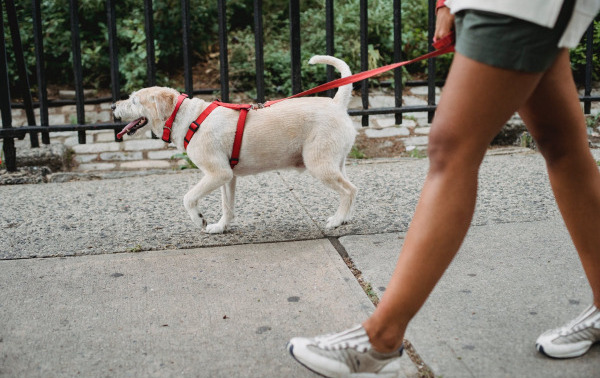
By Nathaniel Fishburn
Your dog may never drink from their water bowl with their pinkies up, or be able to dress in their Sunday best—but what they can do is be steered in the direction of proper etiquette by their attentive and loving owners. Etiquette is not just arbitrary rules of polite conduct—it implicitly respects the wellbeing and happiness of others when making choices around your behavior. In this guide to dog-walking etiquette, our walker Nathaniel will share tips on how to conduct yourself and your pet with the utmost civility. Let’s adjust our reading monocles and take a gander at these tips!
Before the Walk
Before talking about etiquette for when you’re out and about, there are a few things you can do ahead of time to help them be a good neighbor.
Vaccinations
Heavily populated areas can be conducive to viruses such as kennel cough, heartworm, and giardia, among others. Pet vaccinations prevent your dog from contracting and/or spreading diseases, so make sure your pet is vaccinated! Talk to your vet about which vaccinations your dog needs based on what’s common in your area.
ID Microchipping
If your dog somehow gets lost, an ID microchip can help get them back to you as soon as possible. This microchip lies just underneath your pet’s skin between the shoulder blades and is inserted by injection. If your pet is lost, you can notify the microchip manufacturer to put out an alert to rescues, vets, and other shelters to be on the lookout for your pet. Once your pet’s microchip is scanned, your contact information will come up, and the relevant parties will contact you. If you want to be prepared in case of the unthinkable, make sure your pet has or received a microchip implant!
Training
A dog trained in the essential behaviors is a dog that will be safe, happy, and prepared for city life. Trained pets are less prone to leash reactivity, pulling, and other behaviors that may make them difficult to manage while out on a walk. This preparation will also help your pet if you have unwanted encounters with humans or other animals.
Even if you are just getting started on your training journey, you can make positive changes in your pet’s behavior by sticking to consistent behaviors during walks. Dogs thrive on routine! So whether it’s keeping your dog to one side of you, sitting at every crosswalk or whenever you’re about to cross a road, or coming to a stop if they pull ahead, your walking habits will go a long way when teaching your dog proper city-walking etiquette.
Windy City Paws’ training walks teach pups the PAWS-First core behaviors: sit, down, watch me, drop it, touch (a form of “come”), loose leash walking, potty training, and equipment training. If you need a little extra help getting your pet to master these core behaviors, head over to our Training Walks page for more information!
Out and About
Leashes
The first tip for city walking etiquette is a simple one: use a leash at all times!
We at Windy City Paws advocate for walking your dog on a leash whenever in the city. Simply put, urban environments pose enough risks to far outweigh any benefit of walking your dog off-leash. Even if you consider your dog responsive and well-trained, all it takes is a sudden noise for your dog to run off ahead of you. They are still animals who react instinctively, after all!
And to put a finer point on it—off-leash walking is illegal! Even though it’s rarely enforced, you can face a fine (even jail time) for your trouble if your pet gets into a scrape while free-walking.
The best leash for city walking is a four- or five-foot fixed lead. This ensures your pet is within easy reach and that you can keep an eye on them at all times. Fixed-length leashes are preferred over extendable/retractable leashes. The cords on an extendable leash can be hazardous if they wrap around hands, fingers, or paws. These cords are also hard to see if you’re a passerby since they are pretty thin. This means they can be easily missed and result in accidents, especially if your dog rounds a corner ahead of you. While you may feel your dog deserves to roam freely, we at WCP believe there is nothing oppressive about looking out for your pet’s well-being!
While walking with a leash, it’s advisable to keep both hands on the leash at all times. Keep one hand through the end-loop and the other further down the leash to give extra guidance. Provide enough slack to create a J-shape between your lower hand and the dog’s collar or harness. This way, your dog has enough room to walk comfortably and explore without getting too far beyond your attention.
Potty Time
Keep your dog from relieving themselves on private property, including lawns, gardens, flower beds, or the facades of apartment buildings. Encourage your pet to potty in areas like public astroturfed dog runs, gutters, or other public grasses.
Make sure to carry plastic bags with you on every walk, even if you don’t think your pet will poop. If your dog poops and you don’t have a bag, don’t leave the poop alone! Look out for public bag dispensers, which can be found in public dog-relief areas. If those aren’t available, asking a passerby will most often reward you with a plastic bag. If that isn’t an option, make it a priority to return and dispose of the waste at your earliest convenience.
Canine diseases are often shed through poop, which means other animals or people who interact with it, willingly or not, are liable to get sick. Forgetting the medical reasons for a moment, it’s also just unpleasant to see poop all over your neighborhood! If you’re squeamish about using your hands through a plastic bag to pick up your dog’s poo, invest in a scooper and/or hand sanitizer.
Interacting with Pedestrians & Other Dogs
When walking, it’s good etiquette to not let your dog interact with other pedestrians or their pets without that person’s consent. Simply make sure to get verbal confirmation before moving ahead with any contact. Never assume that others want to interact with your dog, even if your dog is the most harmless, friendly, and sweetest pup there ever will be. Just as well, it’s best to not allow strangers to interact with your dog without your permission. Permission goes both ways, and keep in mind that denying an interaction is never personal!
This goes for dog socializing as well while on walks! Get the owner’s permission before allowing your pets to interact. Even if the dogs instinctively want to meet-n-greet, you won’t know if the owner has reasons for not letting them socialize until you ask for permission. If your dogs meet each other, keep an eye on their body language for signs of fear or aggression. Fear will look like backing away, tucking their tail, flattening their ears, or whining. Aggression will look like raising their hackles or curling their lips to show teeth. Don’t be embarrassed or afraid to end the interaction if one or the other or both start to exhibit fear and/or aggression. This is another reason to walk your dog with a leash: if the dogs start to fight, having a leash will make it easier to rescue your pet from the situation!
A simple action you can take to help manage unwanted encounters is to purchase a leash sleeve. Leash sleeves are signs you can slip over the leash or harness that contain important information about your pet from afar: “Nervous,” “In Training,” “Deaf,” “Dog Reactive,” or “Friendly!” Make sure to attach your leash sleeve at the end closest to your pet, as most people will want to look at your dog before you.
Tying Up
If you need to run an errand or plan to visit a restaurant or café, call ahead to ensure you can bring your pet inside or that they have a dog-friendly patio. Tying up your pet while you run an errand or get coffee leaves them vulnerable to unwanted interactions with pedestrians and dogs— even potential thieves! Not to mention, dogs can become highly stressed out when left alone in a strange environment, which increases the likelihood of fear-based reactivity to strangers. So if going into a business means you have to leave your pet unattended, it’s probably best to look for another place or save that errand for another time.
Proper etiquette ensures that your pet, you, and the others around you are taken care of and safe while you’re out on a walk. With these tips in mind, your dog is sure to be a consummate gentle-pup!





